‘Santiago Stadium 1’. Photomontage by Peter Kennard. This image was covered up by Barbican staff so Pinochet officials would not have to see it on the way to meeting with British bankers in 1985.
By Peter Kennard
Declassified UK
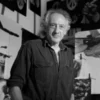 On September 11th 1973 a military coup led by General Augusto Pinochet and backed by the C.I.A. and big business overthrew Chile’s constitutional government and inflicted 17 years of terror on the Chilean people.
On September 11th 1973 a military coup led by General Augusto Pinochet and backed by the C.I.A. and big business overthrew Chile’s constitutional government and inflicted 17 years of terror on the Chilean people.
Salvador Allende, whose ‘Popular Unity’ socialist government had nationalised some of the country’s key assets and resources, died in the coup and a fascist military regime was set up in which thousands were tortured, murdered, and ‘disappeared’ (grabbed from their homes by military thugs and never seen again).
I immediately began making art about it.
Then in 1985, I had a retrospective exhibition titled ‘Images Against War 1965-1985’ at the Barbican Arts Centre in London to coincide with the production of War Plays by Edward Bond at the venue’s theatre.
But the day before the exhibition opened, Henry Wrong [sic], the director of the centre, approached me and demanded that two of the photomontages, ‘Santiago Stadium’ 1 and 3, should be removed immediately. Both works were made in 1973 in response to the military coup in Chile, portraying the bloody repression and killing that followed.

The reason Wrong wanted the Chile images gone was Midland Bank (as it was then known, it’s now HSBC) had hired the Barbican cinema for a meeting between some of Pinochet’s finance officials and British bankers. To access the cinema they would have had to walk past my exhibition. I refused to remove the two works — as did the people who had just hung the exhibition.
Then, the next morning, I went in to see the largest picture to which they had objected was covered over with a moth-eaten felt blanket. It was hung from a high ceiling and must have been too difficult to remove. The smaller one had been unscrewed from the wall and taken down.
The next day, the Evening Standard wrote:
“Peter Kennard’s exhibition, Images Against War, at the Barbican Centre should perhaps be re-titled. Images Against Censorship might not be too wide of the mark.” However, a Barbican spokesman told the paper: “We would hope to accommodate Peter Kennard. It’s his exhibition. We don’t exercise censorship.” Actually they accommodated the fascist regime and censored the artist.
I was initially so incensed I was going to withdraw the whole exhibition, but then I decided to leave it just as the Chileans saw it, with the blanket covering the image and an empty space. The public could view it as another statement against the coup, the regime and its financial backers.
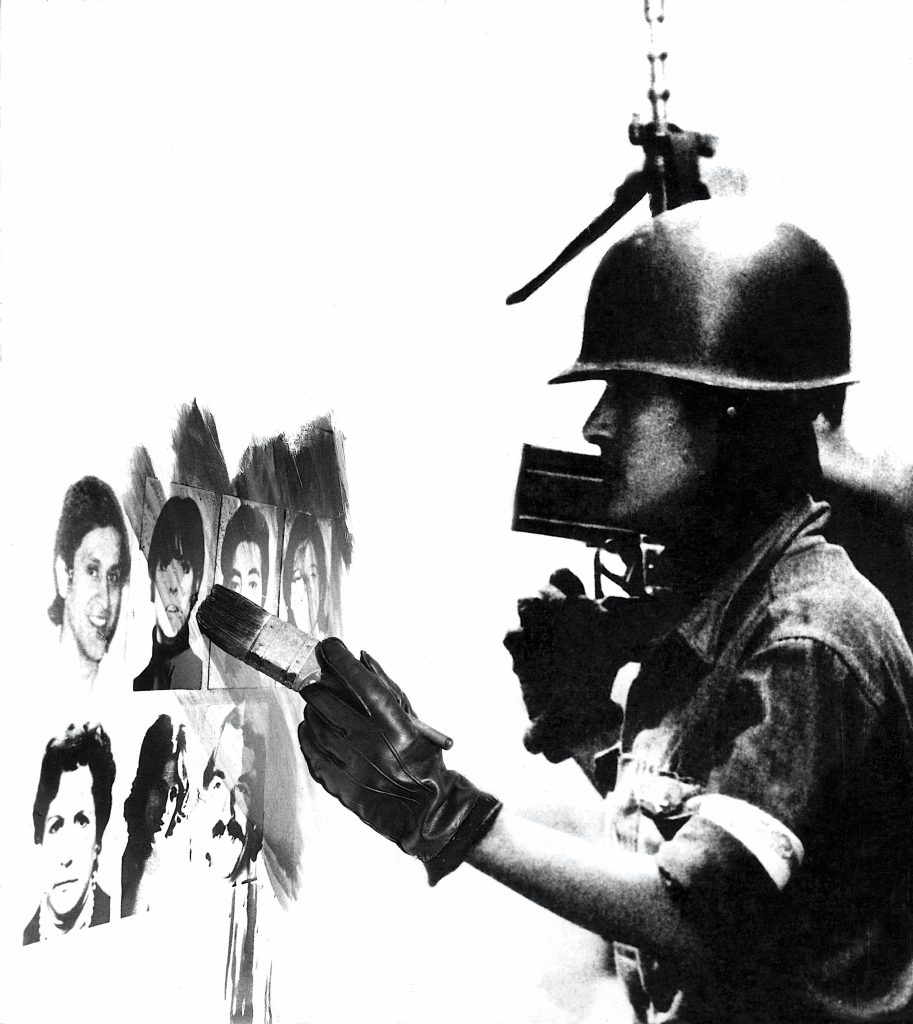
Art Method
The art was my attempt to express my outrage at the horror of the coup and its aftermath. By breaking down elements in photographs of Chile, cutting them up and reconstituting them, a critical narrative of military violence and its opposition was set up.
The resulting images are not documentary mirrors, although some of my photomontages use photographs by documentary and citizen photographers bravely working in life threatening situations. They go out into danger while I work in my studio trying to connect their photographs to the forces that create the oppression their images document. The power brokers behind the suffering are revealed in the same frame as their victims.
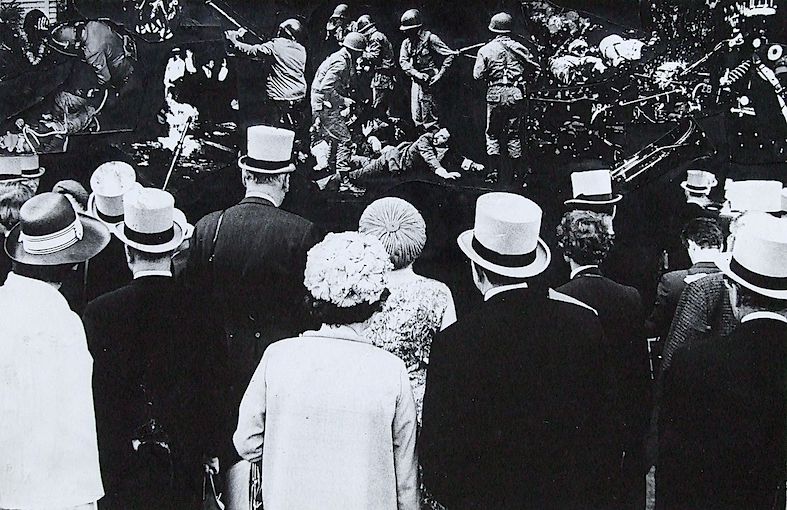
My images were used again in December 1998. Protesters, holding placards illustrated with images of mine about human rights, demonstrated outside high security Belmarsh Magistrates Court in London. Pinochet was due to appear after being arrested under an international warrant issued by Spanish judge Baltasar Garzón. I remember the shudder in the crowd of demonstrators – many of them Chileans who had suffered under his dictatorship – as a car with blacked out windows drove him into the courthouse.
Labour home secretary Jack Straw finally ruled in January 2000 that on health grounds Pinochet should not be extradited and was free to return to Chile, where on arrival, he stood up from his wheelchair in triumph while his supporters cheered.
I’m sure, even though he would have been happy to be back in the country where he’d slaughtered and tortured thousands, that he would miss taking his customary afternoon tea with his friend Margaret Thatcher. A few weeks earlier she had talked about the “debt” the U.K. owed Pinochet and to cheers from delegates at the Conservative Party conference had spoken of his “judicial kidnap” by Baltasar Garzón.
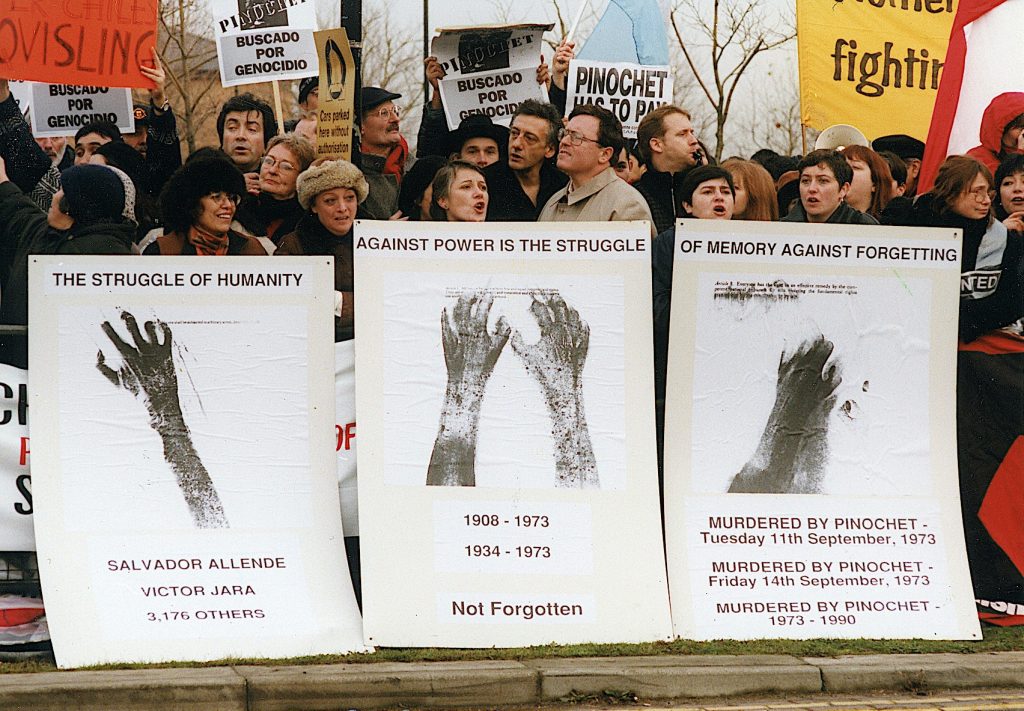
Censorship Worse
In 1978, I had made an exhibition of 30 photomontages ‘A Document on Chile’ with text by Ric Sissons for the Half Moon Photography Workshop. It recounted the history of Chile from the years prior to Allende, the three years of his Popular Unity government through to the barbarism of Pinochet’s rule.
The exhibition was laminated in plastic and travelled in a case that could be sent cheaply in the luggage van of a train. It travelled the country going to community centres, colleges, youth clubs and even a launderette.
To mark the 50 year anniversary of the coup, the exhibition is being re-staged at a gallery in London this week. Unfortunately, nothing has changed 45 years later.
The patrons of contemporary art, the Medicis of today, are the corporations and super-rich art collectors. They give the impression of supporting dissident views and freedom of expression, but if there is any danger that your sponsored work encourages even a modicum of critical debate, you’re out the door. The sponsors are in it to ratchet up “the buying mood”.
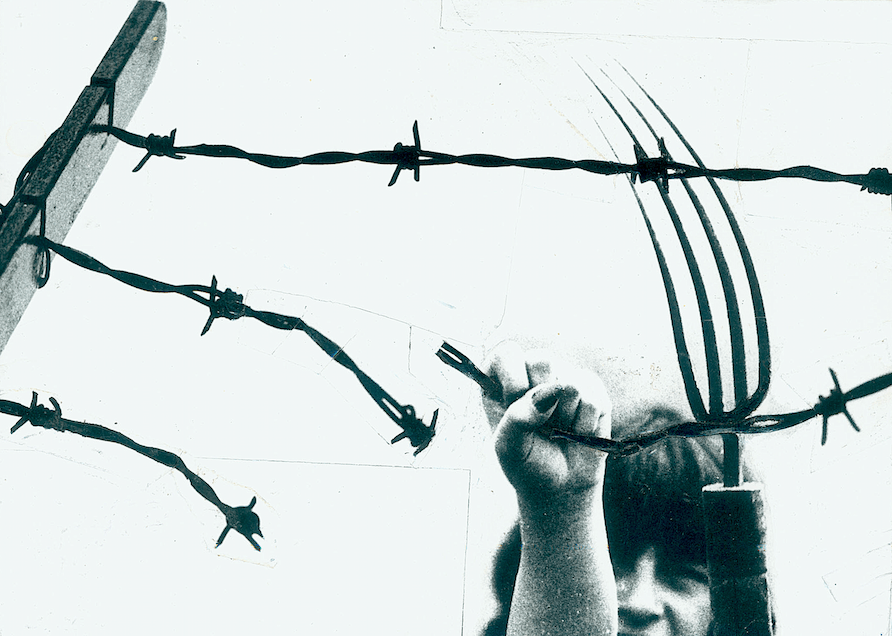
Censorship of culture is something one does not speak of in the free market. But in the visual arts it is an increasing determinant of what people are allowed to see in public spaces. Exhibitions cannot take place if they are not sponsored. Not that long ago, the Tate even had trouble finding a sponsor for a Francis Bacon show, as the work appeared a bit too visceral for shareholders to support.
The Barbican, which censored my anti-fascist art all those years ago, is another example: it’s owned, funded, and managed by the City of London Corporation.
Corporate power rules in the British art world. And its censorship of any dissident views is even more complete now than it was in 1985. The good news is that the next generation of artists are struggling to break the stranglehold of the corporations and investors over the creative industries. It is vital they succeed.
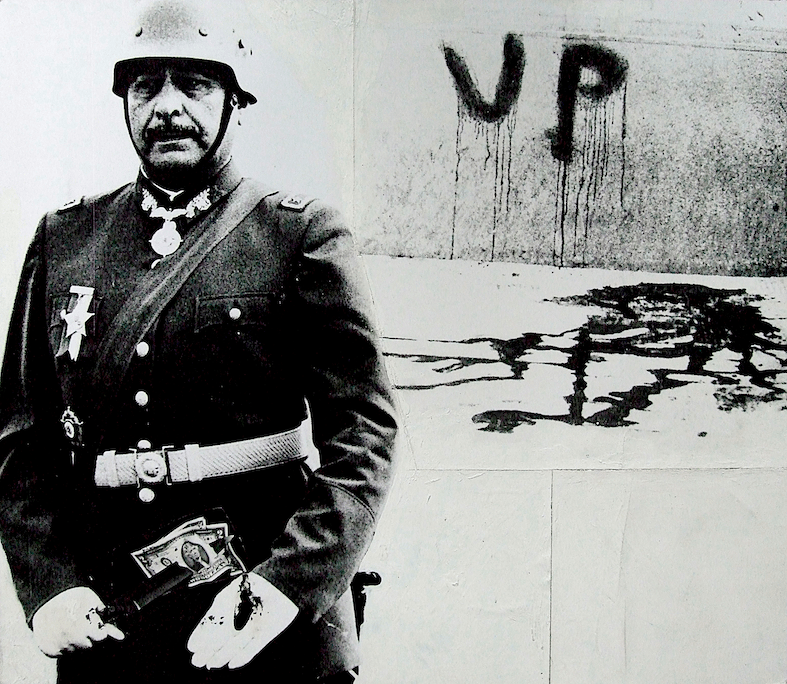
* The exhibition ‘Chile 50: Political Art, Solidarity and Resistance’ will be on at Four Corners Gallery in Bethnal Green, London from September 12-23.
Peter Kennard is an artist and Professor of Political Art at the Royal College of Art in London. His work is in the collection of Tate, the V&A, amongst others.

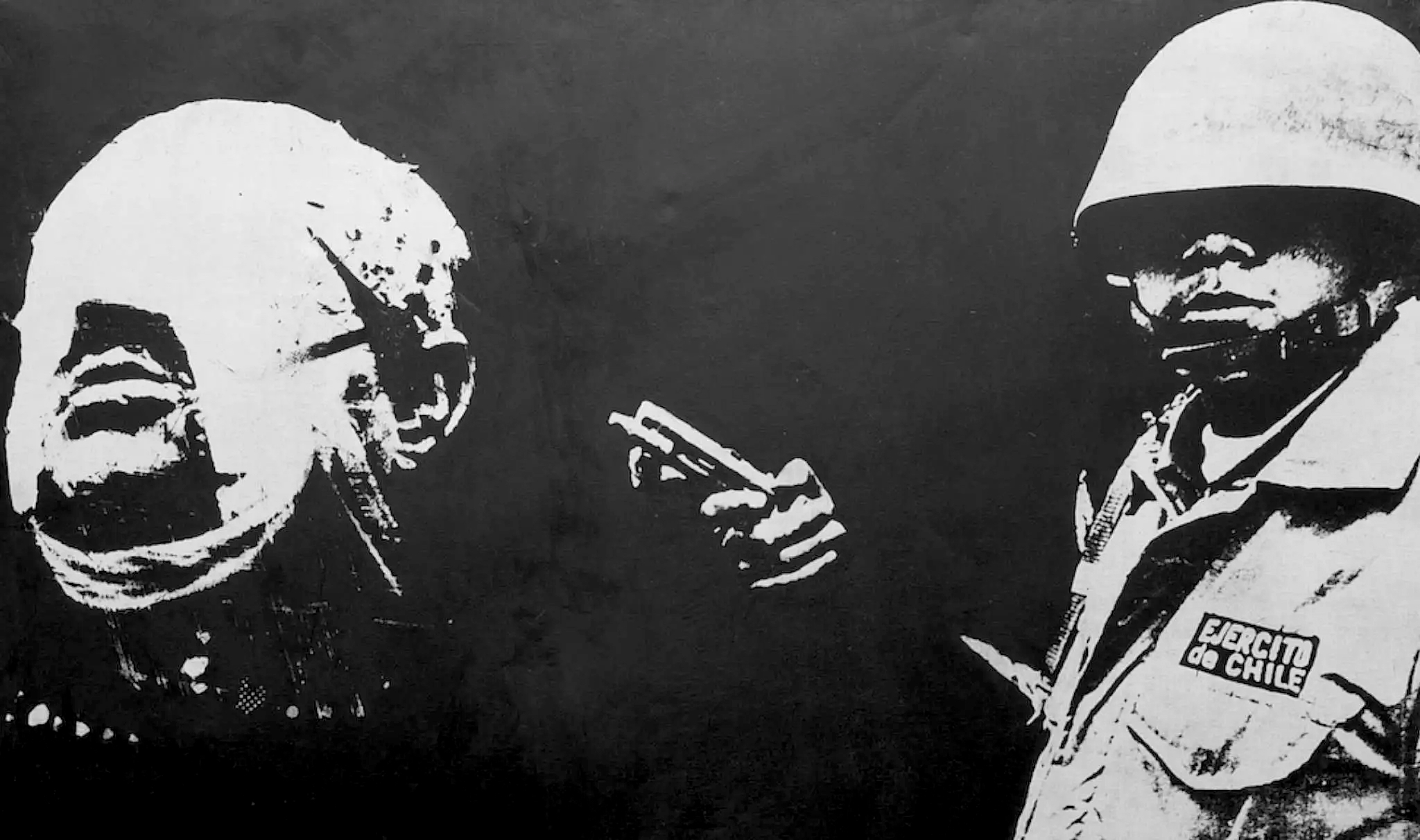
Tribute I wrote to Allende, Stafford Beer, Cybersyn and the fight for democracy in Cuba: hxxps://open.spotify.com/album/61N4RUWDunwm4eCxS82U61
Impressive images. Thank you Peter Kennard.
I dare say that there is no filthy war in the world where the Brits and the Americans did not have a leading role.
It seems that the best of our species trying to fight the evil always get murdered. So sad.
Nixon and Kissenger engineered this coup. Henry Kissenger yet live at the age of 100. That’s 100 years too long!